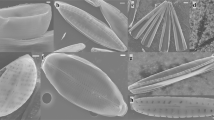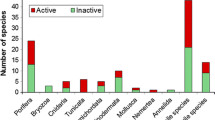Abstract
Evidence is given that odour compounds of diatoms serve as potential repellents for crustacean grazers. Novel repellent-test and odour-test apparatus allowed the determination of repellent activity of diatom derived compounds, activated by freezing and thawing or mechanical disintegration, and pure compounds, respectively. Epilithic diatom biofilms when activated, produced odour compounds that were determined by GC–MS to be polyunsaturated aldehydes (PUA). 2(E),4(Z),7(Z)-Decatrienal and 2(E),4(Z)-octadienal were the major compounds, and 2(E),4(Z)-heptadienal was a minor compound. These PUA were each accompanied by small amounts of the E,E-isomers in positions 2 and 4. 2(E),4(E),7(Z)-Decatrienal was the most active repellent tested and exhibited a RC50 value (indicating the concentration of a compound necessary for a 50% reduction of swimming crustaceans in the assay vial) of 3.5 μM in a defined water column. Quantitative analyses showed that upon activation diatom biofilms produced large amounts of eicosapentaenoic acid (EPA) of which only a minor part was degraded to PUA. The major part of EPA was retained in the cells whilst the major part of PUA was released into the surrounding water. The data are consistent with the hypothesis that diatoms damaged by grazers develop free EPA in the cells that is toxic to grazers, and release PUA into the water that serve as warning signals to grazers. Diatoms and other phytoplankton species, that have the capacity to form these compounds, might benefit from such a reaction because the producers live in colonies or assemblages and the death of one cell liberates a cloud of repellent compounds into the water which reduces the grazing pressure on the remaining cells. Such activated defence reactions may help explain food selection and avoidance in freshwater and marine ecosystems.
Similar content being viewed by others
References
D. Baumgärtner A.D. Jungbluth U. Koch E. Elert Particlevon (2002) ArticleTitleEffects of infochemicals on microhabitat choice by the freshwater amphipod Gammarus roeseli Arch. Hydrobiol. 155 353–367
N. Blackburn T. Fenchel J. Mitchell (1998) ArticleTitleMicroscale nutrient patches in planktonic habitats shown by chemotactic bacteria Science 282 2254–2256 Occurrence Handle10.1126/science.282.5397.2254 Occurrence Handle9856947
M.D.F. Centeno G. Persoone M.P. Goyvaerts (1995) ArticleTitleCyst-based toxicity tests. IX. The potential of Thamnocephalus platyurus as test species in comparison with Streptocephalus proboscideus (Crustacea: Branchiopoda: Anostraca) Environ. Toxicol. Wat. Qual. 10 275–282
W.R. DeMott F. Moxter (1991) ArticleTitleForaging on cyanobacteria by copepods: responses to chemical defenses and resource abundance Ecology 72 1820–1834
M. Durrer U. Zimmermann F. Jüttner (1999) ArticleTitleDissolved and particle-bound geosmin in a mesotrophic lake (Lake Zürich): spatial and seasonal distribution and the effect of grazers Wat. Res. 33 3628–3636 Occurrence Handle10.1016/S0043-1354(99)00069-X
S. Firestein (2001) ArticleTitleHow the olfactory system makes sense of scents Nature 413 211–218 Occurrence Handle10.1038/35093026 Occurrence Handle11557990
S.W. Jeffrey G.F. Humphrey (1975) ArticleTitleNew spectrophotometric equations for determining chlorophylls abc1c2 in higher plants, algae and natural phytoplankton Biochem. Physiol. Pflanzen 167 191–194
F. Jüttner (1981) ArticleTitleDetection of lipid degradation products in the water of a reservoir during a bloom of Synura uvella Appl. Environ. Microbiol. 41 100–106
F. Jüttner (1984) ArticleTitleDynamics of the volatile organic substances associated with cyanobacteria and algae in a eutrophic shallow lake Appl. Environ. Microbiol. 47 814–820
F. Jüttner (2001) ArticleTitleLiberation of 5,8,11,14,17-eicosapentaenoic acid and other polyunsaturated fatty acids from lipids as a grazer defense reaction in epilithic diatom biofilms J. Phycol. 37 744–755 Occurrence Handle10.1046/j.1529-8817.2001.00130.x
F. Jüttner B. Höflacher K. Wurster (1986) ArticleTitleSeasonal analysis of volatile organic biogenic substances (VOBS) in freshwater phytoplankton populations dominated by DinobryonMicrocystisAphanizomenon J. Phycol. 22 169–175
F. Jüttner U. Dürst (1997) ArticleTitleHigh lipoxygenase activities in epilithic biofilms of diatoms Arch. Hydrobiol. 138 451–463
J. Krieger H. Breer (1999) ArticleTitleOlfactory reception in invertebrates Science 286 720–723 Occurrence Handle10.1126/science.286.5440.720 Occurrence Handle10531050
R. Kurmayer F. Jüttner (1999) ArticleTitleStrategies for the co-existence of zooplankton with the toxic cyanobacterium Planktothrix rubescens in Lake Zürich J. Plankton Res. 21 659–683 Occurrence Handle10.1093/plankt/21.4.659
P. Larsson S. Dodson (1993) ArticleTitleInvited review. Chemical communication in planktonic animals Arch. Hydrobiol. 129 129–155
C. Laurén-Määtä O. Kleiven J. Kiviranta (1997) ArticleTitleHorizontal distribution of Daphnia pulex in response to toxic and non-toxic algal extracts J. Plankt. Res. 19 141–148
K.J. Lindstedt (1971) ArticleTitleChemical control of feeding behavior Comp. Biochem. Physiol. 39A 553–581 Occurrence Handle10.1016/0300-9629(71)90319-7
A. Miralto G. Barone G. Romano S.A. Poulet A. Ianora G.L. Russo I. Buttino G. Mazzarella M. Laabir M. Cabrini M.G. Giacobbe (1999) ArticleTitleThe insidious effect of diatoms on copepod reproduction Nature 402 173–176 Occurrence Handle10.1038/46023
P.A. Moore D.M. Fields J. Yen (1999) ArticleTitlePhysical constraints of chemoreception in foraging copepods Limnol. Oceanogr. 44 166–177
D.G. Nagle V.J. Paul (1998) ArticleTitleChemical defense of a marine cyanobacterial bloom J. Exp. Mar. Biol. Ecol. 225 29–38 Occurrence Handle10.1016/S0022-0981(97)00205-0
D.G. Nagle V.J. Paul (1999) ArticleTitleProduction of secondary metabolites by filamentous tropical marine cyanobacteria: ecological functions of the compounds J. Phycol. 35 1412–1421 Occurrence Handle10.1046/j.1529-8817.1999.3561412.x
P.W. Paré J.H. Tumlinson (1999) ArticleTitlePlant volatiles as a defense against insect herbivores Plant Physiol. 121 325–332 Occurrence Handle10.1104/pp.121.2.325 Occurrence Handle10517823
V.J. Paul L. van Alstyne (1992) ArticleTitleActivation of chemical defenses in the tropical green algae Halimeda spp J. Exp. Mar. Biol. Ecol. 160 191–203 Occurrence Handle10.1016/0022-0981(92)90237-5
R.W. Pennak (1973) ArticleTitleSome evidence for aquatic macrophytes as repellents for a limnetic species of Daphnia Int. Rev. ges. Hydrobiol. 58 569–576
G. Pohnert (2000) ArticleTitleWound-activated chemical defense in unicellular planktonic algae Angew. Chem. Int. Ed. 39 4352–4354 Occurrence Handle10.1002/1521-3773(20001201)39:23<4352::AID-ANIE4352>3.0.CO;2-U
G. Pohnert (2002) ArticleTitlePhospholipase A2 activity triggers the wound-activated chemical defense in the diatom Thalassiosira rotula Plant Physiol. 129 103–111 Occurrence Handle10.1104/pp.010974 Occurrence Handle12011342
D.M.C. Rashash A.M. Dietrich R.C. Hoehn B.C. Parker (1995) ArticleTitleThe influence of growth conditions on odor-compound production by two chrysophytes and two cyanobacteria Wat. Sci. Technol. 31 165–172 Occurrence Handle10.1016/0273-1223(95)00472-Y
T. Rohrlack E. Dittmann M. Henning T. Börner J.G. Kohl (1999) ArticleTitleRole of microcystins in poisoning and food ingestion inhibition of Daphnia galeata caused by the cyanobacterium Microcystis aeruginosa Appl. Environ. Microbiol. 65 737–739 Occurrence Handle9925609
F. Roozen M. Lürling (2001) ArticleTitleBehavioural response of Daphnia to olfactory cues from foodcompetitors and predators J. Plankton Res. 23 797–808 Occurrence Handle10.1093/plankt/23.8.797
C.J. Seely M.M.F. Lutnesky (1998) ArticleTitleOdour-induced antipreditor behaviour of the water fleaCeriodaphnia reticulatain varying predator and prey densities Freshwater Biol. 40 17–24 Occurrence Handle10.1046/j.1365-2427.1998.00348.x
B.A. Shaw P.J. Harrison R.J. Andersen (1995) ArticleTitleFeeding deterrence properties of apo-fucoxanthinoids from marine diatoms. II. Physiology of production of apo-fucoxanthinoids by the marine diatoms Phaeodactylum tricornutumThalassiosira pseudonanatheir feeding deterrent effects on the copepod Tigriopus californicus Mar. Biol. 124 473–481 Occurrence Handle10.1007/BF00363922
S. Strom G. Wolfe A. Slajer S. Lambert J. Clough (2003) ArticleTitleChemical defense in the microplankton II: inhibition of protist feeding by β-dimethylsulfoniopropionate (DMSP) Limnol. Oceanogr. 48 230–237
K.L. van Alstyne G.V. Wolfe T.L. Freidenburg A. Neill C. Hicken (2001) ArticleTitleActivated defense systems in marine macroalgae: evidence for an ecological role for DMSP cleavage Mar. Ecol. Progr. Ser. 213 53–65
E. van Gool J. Ringelberg (1996) ArticleTitleDaphnids respond to algae-associated odours J. Plankton Res. 18 197–202
T. Wendel F. Jüttner (1996) ArticleTitleLipoxygenase-mediated formation of hydrocarbons and unsaturated aldehydes in freshwater diatoms Phytochemistry 41 1445–1449 Occurrence Handle10.1016/0031-9422(95)00828-4
T. Wendel F. Jüttner (1997) ArticleTitleExcretion of heptadecene-1 into lakewater by swarms of Polyphemus pediculus (Crustacea) Freshwater Biol. 38 203–207 Occurrence Handle10.1046/j.1365-2427.1997.00207.x
G.V. Wolfe (2000) ArticleTitleThe chemical defense ecology of marine unicellular plankton: constraints, mechanisms, and impacts Biol. Bull. 198 225–244 Occurrence Handle10786943
Author information
Authors and Affiliations
Corresponding author
Rights and permissions
About this article
Cite this article
Jüttner, F. Evidence that Polyunsaturated Aldehydes of Diatoms are Repellents for Pelagic Crustacean Grazers. Aquat Ecol 39, 271–282 (2005). https://doi.org/10.1007/s10452-005-3419-9
Received:
Accepted:
Issue Date:
DOI: https://doi.org/10.1007/s10452-005-3419-9




